FIG. 2.
The ATR1 gene provides boron resistance. (A) Wild-type strain W3031-a and its isogenic atr1Δ mutant were grown to logarithmic phase in rich (YPD) medium, and the cultures were diluted to an OD600 of 0.2. Five microliters of each cell suspension was spotted on plates containing the indicated amounts of boric acid. The plates were incubated at 30°C for 5 days and photographed. (B) ATR1-overexpressing wild-type and atr1Δ cells were grown in the presence of the indicated concentrations of boron. Cells transformed with an empty vector were used as a control. (C) Comparisons of the boron tolerances of atr1Δ, bor1Δ, dur3Δ, and fps1Δ mutants. Overnight cultures were diluted to the indicated densities, and 5 μl of each cell suspension was spotted. The cells were grown for 3 days, and the plates were photographed.

